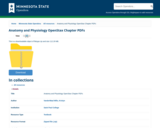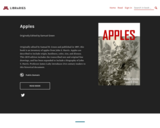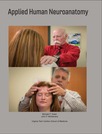
These are PDFs of each chapter of the OpenStax Anatomy and Physiology textbook. They can be posted to D2L for easy access for students.
- Subject:
- Biology
- Life Science
- Material Type:
- Textbook
- Provider:
- Minnesota State Opendora
- Date Added:
- 11/30/2020


These are PDFs of each chapter of the OpenStax Anatomy and Physiology textbook. They can be posted to D2L for easy access for students.

Veterinary nurses need to have a firm grasp of the normal structure of an animal’s body and how it functions before they can understand the effect diseases and injuries have and the best ways to treat them. This book describes the structure of the animal body and the way in which it works. Animals encountered in normal veterinary practice are used as examples where possible.

Introduction to Biotechnology II (BIOL1415), provides learners with a practical exploration of a regulated biotechnology workplace. This course is a continuation of Introduction to Biotechnology I (BIOL 1414), and the cornerstone for the Biotechnology Level-One Certificate, as it provides students ample opportunity to master entry-level laboratory workforce skills. This course builds on knowledge in biotechnology, chemistry, & biology, and provides workforce training in areas of regulatory documentation, equipment validation, and teamwork. The goals of this course are to develop core laboratory skills needed in a bioscience lab job; critical thinking and multitasking, teamwork and accountability, accuracy in calculations and experimental analysis, and demonstrate skills associated with working in a regulated laboratory workplace.

The introductory topics will cover various approaches to the study of animals and their behavior. Key concepts in studies of animal behavior, emphasizing ethology, are covered in class and in the assigned readings from Scott (2005), supplemented by selections from other books, especially from classics in the field as well as selected videos. Next, key concepts in sociobiology are covered using readings from Alcock (2001), supplemented by selections from additional books and some video presentations.

Animal welfare has been described as a complex, multi-faceted public policy issue which includes important scientific, ethical, and other dimensions. Improving our understanding of animal welfare, involves the fascinating study of animal behavior as well as the challenge of accessing the emotions of animals.
This is the On-Demand version of this course, which means you can start the course at any time and work through the course materials at your own pace. The materials and quizzes will always be available to you.
You can come and talk about the course on Twitter using the hashtag #EdAniWelf

Hello Readers, My name is Eddie Joo and I am the co-author as well as the person behind the cover art for this OER. The reason I chose the specific elements on the cover are relatively simple. I dislike the textbooks that just slap random images or things related to the subject and make the cover look really busy. I don't know about you, but any poster or ad that has something to do with Alaska usually includes mountains so I chose the ocean/water instead. Same reason with the animals as the Bear, Wolf, etc. are the go to animals when portraying Alaska so a Dall Sheep, Orca, and an Owl grace the cover. Last but most important to me is the sunrise/sunset gradient. I love seeing both in the winter and is special to me so I added it in as a little Easter egg for me. I hope you enjoy this book! Regards, Eddie
Long Description:
This book is the first edition (Fall 2022) to the exploration of two main core concepts in physiology; Systems Integration, and Homeostasis, in animals at the tissue and organ system level. The flow of this book focuses on how organ systems work together. Foundational homeostatic principles are introduced within the first chapter and threaded throughout the chapters within this text. This text was created by Eddie Joo to supplement students learning within the University of Alaska Anchorage’s Animal Physiology course. The content in this open textbook was adapted from other open textbooks (CC-BY-4.0) resources or created/written by Rachael Hannah and Eddie Joo. This work was funded by an Institutional Development Award (IDeA) from the National Institutes of Health as a Curriculum grant from ALASKA INBRE.
Word Count: 53586
(Note: This resource's metadata has been created automatically by reformatting and/or combining the information that the author initially provided as part of a bulk import process.)

The lethal poison Ricin (best known as a weapon of bioterrorism), Diphtheria toxin (the causative agent of a highly contagious bacterial disease), and the widely used antibiotic tetracycline have one thing in common: They specifically target the cell’s translational apparatus and disrupt protein synthesis.
In this course, we will explore the mechanisms of action of toxins and antibiotics, their roles in everyday medicine, and the emergence and spread of drug resistance. We will also discuss the identification of new drug targets and how we can manipulate the protein synthesis machinery to provide powerful tools for protein engineering and potential new treatments for patients with devastating diseases, such as cystic fibrosis and muscular dystrophy.
This course is one of many Advanced Undergraduate Seminars offered by the Biology Department at MIT. These seminars are tailored for students with an interest in using primary research literature to discuss and learn about current biological research in a highly interactive setting. Many instructors of the Advanced Undergraduate Seminars are postdoctoral scientists with a strong interest in teaching.

El presente manuscrito es resultado de investigaciones multidisciplinarias bajo diferentes perspectivas científicas-académicas, mediante la confrontación de criterios de diferentes autores bajo un enfoque descriptivo que señala la importancia de ética en varios escenarios actuales como son en la discriminación de la mujer en ambiente laboral, el manejo de los individuos dentro de las organizaciones, dentro de la agricultura al momento de producir y cultivar, como la ética afecta al clima organizacional y lagestión docente dentro del caso de estudio de una universidad, la ética y la responsabilidad social empresarial como reto de las empresas, la discriminación laboral como comportamiento poco ético en el área de recursos humanos, y por ultimo una contrastación de la ética en la publicidad de las empresas. Estos estudios se realizan desde una mirada científica y se la acerca a la realidad ecuatoriana.

Short Description:
Originally edited by Samuel B. Green and published in 1897, this book is an inventory of apples from John S. Harris. Apples are described to include origin, hardiness, color, size, and disease. This 2019 edition includes the transcribed text and original line drawings, and has been expanded to include a biography of John S. Harris. Professor James Luby introduces 21st century readers to this historical document.
Word Count: 20069
ISBN: 978-1-946135-56-8
(Note: This resource's metadata has been created automatically by reformatting and/or combining the information that the author initially provided as part of a bulk import process.)

The eBook “Applications of Plant Pathology in Genebank Collections” was developed in part by USDA-ARS and by grant 2020-70003-30930 from the USDA-NIFA-Higher Education Challenge Grant Program. Additional chapters will be added to this eBook when they are available. This eBook contains chapters that can be accessed in any order. Click on “Contents” in the upper left corner and then expand “Main Body” to access chapter titles; scrolling may be necessary to view all chapter titles. Chapters can also be navigated by using arrows at the bottom of each page. Each chapter has text, video and/or interactive content on a single page.

Applied ecology is a framework for the application of knowledge about ecosystems so that actions can be taken to create a better balance and harmony between people and nature in order to reduce human impact on other beings and their habitats.

About this book
Origin story
I (Erin) began this book project after participating in the Open Pedagogy Incubator hosted by the NC State University Libraries in 2020, with the goal of making my course materials – and information about Applied Ecology – more broadly accessible to students, educators, and the general public. Rather than impose my sole voice, perspective, and biases, I restructured my course assignments to enable student creation of the content you will encounter in this book. The assignments are open-ended and open-world, motivating students to collaborate with each other and to seek knowledge beyond the classroom, and thus embody core characteristics of the discipline of Applied Ecology as well as Open Education and Universal Design for Learning. I hope that by centering student voices and by highlighting diverse scientists, research systems and ecosystems, this work empowers the reader and highlights the relevance of Applied Ecology in our everyday lives.
Intended use
This book is formatted to provide information about key ecological principles, concepts, and processes, explored and applied across various contexts. The text can be used as a foundational or supplementary text for ecology courses, or as a standalone reference for students in formal academic settings or beyond.
The Vocabulary terms at the beginning of each chapter are listed in the order that students will encounter them while reading the blog-style summary for that chapter. The Glossary lists all terms in the entire book in alphabetical order, for quick reference as needed.
We have provided an appendix with skeletal outlines that students can use to guide their notetaking. I also intend to compile a companion volume for educators, containing templates for each assignment used to guide the student works presented here.
Accessibility
We use sans-serif fonts to facilitate readability in digital format and by readers who are neurodivergent. We also support screen readership through alt-text images.

The structure of the human body is usually considered in courses in gross anatomy. These courses typically consist of lectures by the faculty, readings in assigned textbooks and the study of photographs and illustrations in human anatomy atlases. However, as student’s progress through the curriculum and move into the more clinical or practice oriented phases, many discover that the anatomical knowledge they actually need is somewhat different from the kind they possess. What many encounter is difficulty in applying their knowledge to a clinical setting.
Applied Human Anatomy was created to better integrate material that is more often than not treated separately in contemporary health care curricula. It is hoped that through this integration students will develop a deeper and more lasting knowledge and understanding of human anatomy as they are likely to need it in the evaluation and management of patients.
A print version is available for purchase on Amazon.

This 155-page manual is comprised of two types of learning activities: 1) free response fill-in-the blank questions focused of the facts and principles of neuroanatomy and neurophysiology that underpin the neurologic examination and specifically developed exercises that demonstrate how the facts and principles are related to the particular tests and procedures that comprise the neurologic examination. Free response questions form the bulk of the Neuroscience Review section of each chapter and are intended as a review of information previously or concurrently being learned regarding the structure, function and organization of the nervous system. Some questions focus on anatomical or physiological facts and relationships that help explain why certain techniques are performed as they are, such as why non-nociceptive tactile stimuli are required in order to activate nerve impulse transmission in the lemniscal system. Other questions are intended to revisit facts and concepts that are needed to properly interpret the elicited findings. 2) The Application Exercises of each chapter are designed to demonstrate how neuroanatomical and neurophysiological information is used in the design of particular clinical tests of neurologic function. The application exercises are also intended to help users learn how to perform and become comfortable with the various clinical maneuvers and tests that comprise the routine neurologic examination. An important outcome of performing these exercises is that, as a member of a learning group, each individual has the opportunity to experience the neurologic examination from the point of view of the subject (patient)—an experience that arguably provides insight and understanding that can be gained in no other way.

7.003 is an experimental biology course. You will spend most of your time in the teaching laboratory practicing fundamental techniques in molecular biology, genetics, and cell biology, and working with the model organism Saccharomyces cerevisiae (budding yeast). In addition to learning how to accurately and safely perform these techniques, we want to help you understand how and why they work and what scientific questions they can address. The goal is for you to be able to design your own experiments to perform by the end of the semester.

Grade level: graduate students, advanced undergrads, persons with analyzed research results
Course length: 1 semester, 4-6 months
Objective: This course empowers scientists to engage with their own data, each other, and the public through art. Through collective brainstorming, prototyping, and feedback from professional artists, students will create a project that expresses their own research through any artistic medium of their choice. The course typically culminates in a public art exhibition where students interact with a general audience to discuss their research, art, and what it means to be a scientist.

OER | Biology Overview:
On this webpage you will find OER Biology textbooks along with supplemental materials and a few lecture videos.
The purpose of these discipline-specific webpages is to display content that might be of interest to faculty who are considering adopting open educational resources for use in their classes. This list of content is by no means exhaustive. The nature of open educational resources is very collaborative and it is in that spirit that we encourage any comments about the content featured on this page or recommendations of content that are not already listed here.

BI 101 is an introductory lab science course intended for majors in disciplines other than the biological sciences. This course is designed to help you discover the applications of science to your everyday life, as well as provide elements of critical thinking. This course has four Credit Units that emphasize a variety of topics including ecological principles, biodiversity, and impact of human activities on the environment.
Course Outcomes:
1. Discuss biological community interactions.
2. Explain how changes in human population and/or actions impact natural ecosystems.
3. Describe the movement of energy & nutrients through trophic levels.
4. Recognize the appropriate taxonomic level of an organism based on key characteristics or traits.

This is an introductory lab science course intended for majors in disciplines other than the biological sciences. The topics presented include biological molecules, cellular biology, genetics and inheritance, biotechnology, and evolutionary processes. Additionally, the course is designed to help you discover the applications of science in your everyday life, as well as provide elements of critical thinking.
Course Outcomes:
1. Explain how natural selection drives evolution.
2. Express how changes in the genome can affect the phenotype or traits within a population.
3. Be able to describe the patterns of inheritance.
4. Be able describe selected key cell processes.
5. Distinguish between the groups of biomolecules.

This course is designed to be taught using the textbook Cell Biology for Health Occupations, adapted from OpenStax.
(http://cnx.org/contents/Th3V8ojZ@3.1:zMTtFGyH@4/Introduction).